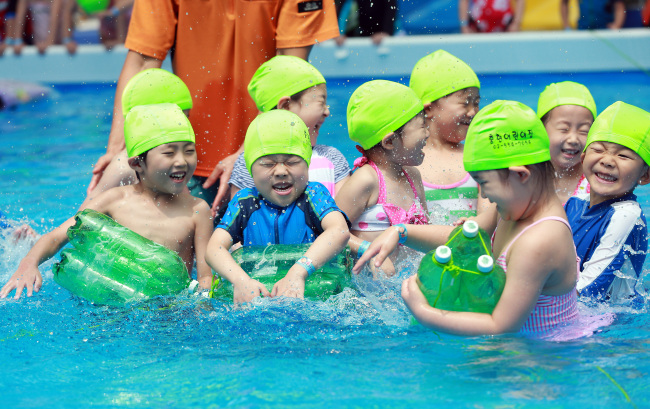Swimming pools and beaches mean summer fun for children, but not taking the proper precautions could be serious or life-threatening.
The Health Ministry last week issued water safety guidelines to the public, as more than half of drowning cases in the country occur during the summer. It is the third leading cause of accidental death for Koreans aged 20 and under.
The number of drowning cases has risen in Korea since 2009, according to Statistics Korea. Some 4,000 water-related accidents occurred and 712 people drowned in 2012, up from 577 in 2009 and 637 in 2010.
The state agency also found that young men are 3.8 times more likely to drown than women, based on statistics from 2003 to 2011.
The Health Ministry last week issued water safety guidelines to the public, as more than half of drowning cases in the country occur during the summer. It is the third leading cause of accidental death for Koreans aged 20 and under.
The number of drowning cases has risen in Korea since 2009, according to Statistics Korea. Some 4,000 water-related accidents occurred and 712 people drowned in 2012, up from 577 in 2009 and 637 in 2010.
The state agency also found that young men are 3.8 times more likely to drown than women, based on statistics from 2003 to 2011.

“Drowning often occurs with young and healthy individuals,” said an official from the Korea Centers for Disease Control and Prevention. “But these deaths are preventable if proper precautions are taken. We especially need to protect and educate children and male teenagers.”
The Health Ministry said a child should never go into the water alone, as many child drowning incidents occur when they are left unattended by adults. “Even if your child is not in the water, do not leave them near any water alone,” the ministry said.
Drowning is quick and very often silent, as the person cannot obtain enough air to shout for help. It only takes a few seconds for a child to drown, and children aged 4 or under can drown in waters of less than 6 centimeters in depth.
Every child should wear a life vest when going into the water, and should not run around the edge of swimming pools.
The ministry also said children should wear water shoes or special sandals that do not fall off in the water. Many children are injured while trying to grab a shoe that fell off while swimming in the ocean or pools, they said.
Children also should not be allowed to chew gum while in the water. Additionally, it is important to do appropriate warm-up and cool-down activities, such as stretching and holding the stretch for about 15 seconds, the ministry said.
“Make sure your child rests for at least 30 minutes after they spend time in the water under the sun,” they said.
Even when spotting a drowning victim, people should not jump into the water to rescue them unless they have been properly trained, the ministry said.
The first step is to let the authorities or life guards know, and then try to get a flotation device such as a life jacket or a rescue tube to throw to the victim so that they have something to hold on to while waiting for rescuers.
Though very often silent, active drowning victims ― those who are conscious and struggling ― display particular characteristics. Their bodies might stay very low in the water, with the mouth just above the surface, or they may stay vertical in the water with their arms thrashing.
For more information on water safety, visit www.cdc.go.kr.
By Claire Lee (dyc@heraldcorp.com)


















